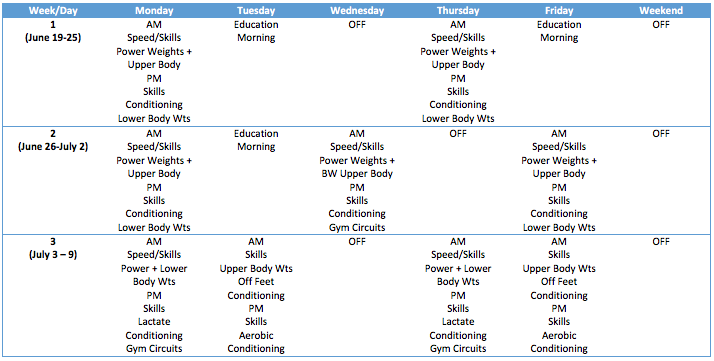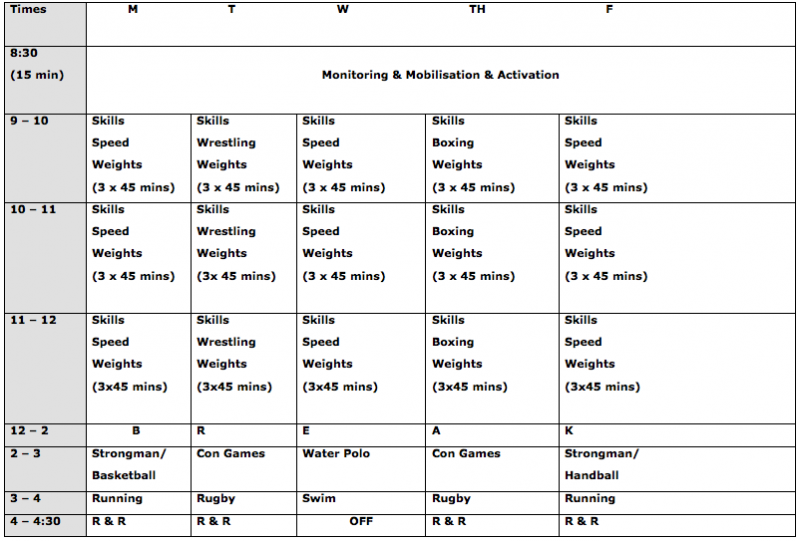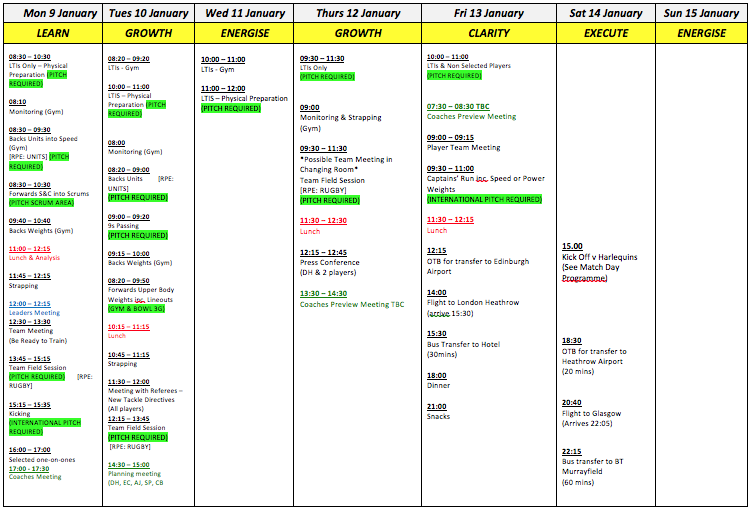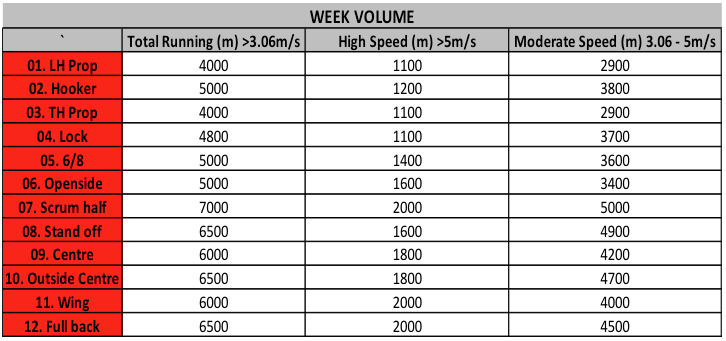
For me, no one has said it better than Damian Marsh, current Head of Strength and Conditioning for the Queensland Reds, an Australia-based team in the Super Rugby competition:
“It is all about the buy-in you get from the players you have in the environment you help to create.”
To get that crucial buy-in, you must work with each player to plan his week to see what works for him, what he did at previous teams, and what his likes and dislikes are. This will help you find out what spins his wheels. Of course you need honesty from the player; it is a joint effort to ensure the team benefits. A wonderful quote comes to mind: "If the team is successfulthen by association I am successful. The name on the front of the uniform is more important than the name on the back of it."
RECENT: Regular Testing for Physical Improvement in Rugby
Firstly then, let us take a look at the yearly plan in a broad overview, so you can get an indication to what a player has to do each year. Working in a northern hemisphere competition, there are some down weeks within the yearly plan that no games are played, and of course no player would be expected to play in all games.
Season Overview
- June: Off-Season, National Team Tour (Two or Three Matches)
- July–August: Pre-Season (Two or Three Trial Matches)
- September–May: In-Season Domestic and European Matches (Potentially 33 Matches)
- November: Internationals (Three or Four Matches)
- February-March: Six Nations (Five Matches)
Processes
For me, the Holy Grail of team sports programming is the individualization of the training stimuli to ensure the players, each and every one of them, get what they need to play to their potential each and every week of the year. Since every player will recover from different training stimuli at different rates and some training sessions are in the non-negotiable column, we as strength and conditioning coaches must allow for these variations of individuals in the programming of the physical parameters each week. The sports content sessions are like the lectures in a university course: they must be attended, but the physical development program aligned to it are the tutorials where individuals are fine-tuned to meet their own personal requirements within the team setting. To achieve this, regular one-on-one interviews need to be scheduled. I like to try and do these monthly so that we can stay on top of any changes that need to be scheduled for the player. Ideally we will have one master plan, and then 45 individual plans aligned to it.
In this interview, some of the key questions that are addressed are:
- Who is the best player in your position in world rugby? What makes him the best?
- What is your limiting factor for improved rugby performance?
- How do we program what you need to do into the team weekly plan to ensure you are doing what you need to get better?
The essence of the style of program development is to treat each player like an individual — a holistic process of individualize to prioritize to optimize performance.
I think we need a change of focus, emphasizing how much training a player needs to do in each of the key areas of physical development rather than how much training can a player tolerate. The ability to train is dictated by a person’s ability to recover, so many factors need to be considered when developing the individualized plan.
Training age dictates degrees of freedom and self-determination.
First and second year professional players have yet to earn the right to program much outside what is given within the generic aspect of the program, especially the strength program. This is more a case of learning your trade. My article on the quadrant system of management details the steps a player would go through to progress through to a more self-determination style of programming within the gym setting. The degrees of freedom I refer to are exercise selection, loading methods, and the training split.
Exercise Selection Chart
The first thing I attempt to do when I move into a new program is to go through the gym and perform an exercise inventory of all the exercises that can be performed using the equipment that we currently have, then assess what we would need to add to the existing selection to improve our exercise selection capability. The categories of exercise selection will differ for each and every strength coach, I am sure, but for me these would include the following:
- Lower Body Maximal Force
- Full Body Power
- Posterior Chain
- Hamstring
- Single Leg
- Upper Body Horizontal Push
- Upper Body Horizontal Pull
- Upper Body Vertical Push
- Upper Body Vertical Pull
- CARE (Core Abdominal Rehab Exercises)
Loading Methods and Cycles
Next to consider is what the plan of training will be for the upcoming block, taking into considerations whether it is a size, strength, or power focus for each group and the individuals within the group. I follow a very concurrent style of programming that addresses priorities in the player’s physical plan; do what matters most and prioritize from that point. There are so many options here to consider, but once again choice is dictated by specific goal of training, as the priority. You can use multiple options in each session and stay with a method for a period of time based on your training age. The greater the training age the quicker the adaptation and the more frequent the change in methods required. My personal favorite methods are below, but do not let your preferential biases dictate the training for each and every athlete. Find out what works best for them:
Size
- 30, 40 or 50 reps in as few sets as possible at 6RM, 8RM and 10RM with only 30 seconds rest between sets.
- 6 x 6 with 75%, 8 x 8 with 70%, or 10 x 10 with 65% Gironda to German Volume Training
Size Wave
- Week 1 - 2 x (15, 12, 10)
- Week 2 – 2 x (12, 10, 8)
- Week 3 – 2 x (10, 8, 6)
Strength
Wave Loading
- Week 1 – 2 x (6, 5, 4)
- Week 2 – 2 x (5, 4, 3)
- Week 3 – 2 x (4, 3, 2)
Cluster Sets
- Week 1 – 4 x (3/3)
- Week 2 – 4 x (2/2/2)
- Week 3 – 4 x (3/2/1)
- All with 20 seconds rest between clusters and three to five minutes rest between sets
Straight Sets
- Week 1 – 5 x 5
- Week 2 – 2 x 5, 3 x 3
- Week 3 – 5/3/1/1/1
Power
Use velocity-based training with designated velocity ranges working at different positions on the force-velocity curve, combining ballistics, medicine ball, speed-strength, and strength-peed movements paired with respective velocities. Refer to the work of Bryan Mann and Dan Baker for extensive reviews of this type of training.
Contrast Loading: Straight sets or cluster sets superset with a plyometric or medicine ball exercise.
Straight Sets
- Week 1 – 5 x 5 + 5 box jumps after each set of squats
- Week 2 – 2 x 5, 3 x 3 + equal number of repeat hurdle jumps
- Week 3 – 5/3/1/1/1 + depth jumps from an increasing height each set
Cluster Sets
- Week 1 – 4 x 3/3 + 6 medicine ball chest pushes against a wall
- Week 2 – 4 x (2/2/2) + 6 clap push-ups after each cluster
- Week 3 – 4 x (3/2/1) + 6 drop rebound push-ups between boxes
Combination Strength and Size
- Work up to a 1RM by whichever means you find best for you, then perform three drop sets for as many reps as possible on each of the drop sets with a three-minute rest between each of the back-off/drop-off sets, using 90%, then 80%, and finally 70%.
Training Split
The final aspect to consider is the number of sessions in the training week, which are dictated by the type of training that the player requires to optimize his development. This will vary from player to player and it is up to the strength and conditioning staff to organize blocks of time in the training day to accommodate these specific preferences and try and block like-minded programming variables together. Ideally, moving along the neural to metabolic continuum, daily programming should reflect this by having sessions of more neural demand earlier in the training day and those sessions of a higher metabolic demand later in the day where possible. This should also be applied to the entire week so that sessions with high neural demand are performed as fresh and recovered as possible, so that a player can best express and develop power, speed, and strength.
Depending on the needs of the player, this is best demonstrated in the off-season and pre-season plans, which is the best opportunity to allow for this needs-based programming to be instituted. Following on from initial testing to ascertain metabolic, specifically aerobic capacity, players can be initially placed in one of three major groups: fitter, faster, or forceful. These groups are then further sub-divided in relation to the physical preparation areas and the number of sessions that each player may need to perform to improve certain physiological states. These are:
Weight Room
- Speed and Power
- Strength
- Size
- Metabolic (Circuits)
Conditioning
- Off-Feet
- Running, Repeated Speed, Lactate Tolerance, MAS, Conditioning Games
- Swimming
- Combat Activities
- Major Games
Speed
- Acceleration and Power
- Maximal Velocity
- Agility and Lateral Quickness
Neural Group Session Profile
Three Sessions Speed
- Monday: Acceleration/Max Velocity
- Wednesday: Speed/Power Combo
- Friday: Acceleration/Max Velocity
Three Sessions Conditioning
Three to Four Sessions Weights
- Full Body or Upper/Lower Split Monday/Wednesday/Friday
Mechanical Group Session Profile
Two Sessions Speed
- Monday: Acceleration/Max Velocity
- Wednesday: Speed/Power Combo
Four Sessions Conditioning
Seven Sessions Weights
- Monday/Wednesday/Friday: Lower Body Power/Strength
- Tuesday/Thursday: Double Day Upper Body Hypertrophy
Metabolic Group Session Profile
One Session Speed
- Wednesday: Speed/Power Combo
Five Sessions Conditioning
Five Sessions Weights
- Monday/Friday: Beastly Circuits
- Wednesday: Lower Body Strength/Power
- Tuesday/Thursday: Upper Body Size/Strength
Off-Season Plan
Players need to get away from the day-to-day environment. This is a time where any surgeries that are required can be booked in and organized, and allows players to rest mentally and physically from the stresses both physiological and psychological of the training and playing week. I would recommend a two-week rest period from all work but keep active with other sporting activities or hobbies that you do not get much of a chance to do during your season, then reintroduce weight training and some light cardio work and gradually build into training. But I would suggest a full mental break from any rugby from four to six weeks so that you are mentally refreshed starting the pre-season. In a previous article here at elitefts.com, I included an entire off-season plan for rugby players to train with, which you can use in any off-season plan irrespective of your sport.
Pre-Season Plan — Developing Acute and Chronic Work Load Parameters
This program is designed to gradually introduce the players to increases in loading over a three-week block to allow for adaptation to take place and to build tolerance to training. The work of Tim Gabbett has significantly influenced the idea that it is not the absolute load that increases the potential for injury. It is significant spikes in load relative to that which the players have become accustomed to over time. This is known as the acute-to-chronic workload ratio, which has been validated for a number variables such as total distance, high speed running ,and session-RPE at highlighting increased soft tissue injury risk. This ratio is calculated over a set time frame relevant to your competitive schedule, such as seven to 28 days if you play one game per week. Keeping in a zone of 0.8 to 1.3 would be ideal conditions for physical improvement without a spike in injury potential, which is seen when this range is compromised on either side of the numbers. Incidence of injury tends to increase when this ratio is greater than 1.5.

First Two Weeks
Lower body weights, followed by calf raise, standing and seated, neck, core, and Nordics
Lower Body
2 x Unilateral Push Options (Sprinter’s Squat, Bosch Squat, Step-Up Variations, Lunge Variations, Pistol Squat with Counter-Movement, Prowler Push, DB Skater Squat)
superset with
2 x Unilateral Pull Options (Split Stance RDL, Single-Leg RDL Variations, Single-Leg Hip Thrust, Single-Leg Back Extension, Pendulum Quadraped Hip Extension on Reverse Hyper, Single-Leg Reverse Hyper)
Also include upper body push and pull supersets with reps in the six or greater range, including bodyweight exercises and multi-planar movements where possible.
Choose one from each of the categories below to perform in this session; performance is the key for selection. Perform as a modified giant set with 60 seconds rest in between each of the four movements and then three to five minutes rest between each of the giant sets.
Speed
One to five reps through the gates.
- 10 meters, 20 meters and 30 meters
Weighted Power Movements
3 x 3 – 5 with 60%-80%
- Cleans or Snatch or Pulls from Floor/Hang/Blocks
- Hip Thrusts with Bands or Bar
- Jump Squats or Quarter Squats in Rack
3 x 10 Meters
- Prowler Push (High or Low Handles)
- Weighted Sled Sprint/March
3 x 10 Each Leg
- Banded Leg Drive
Medicine Ball Movements
3 x 5
- Scoop Toss
- Reverse Toss
- Chest Press
- Woodchop Throw
Unweighted Lower Body Plyometric Movements
3 x 5
- Box Jumps/Hops
- Depth Jumps
- Repeat Long Jumps/Hops
- Repeat Hurdle Jumps/Hops
- Borzov Hops
- Alternating Bench Blasts
- Knees to Feet
Upper Body
- 2 x Push Options (Bench Press, Incline Bench Press, Military Press, Push Press, Close Grip Bench Press, DB/KB/Cable/Machine Variations)
- 2 x Pull Options (Pendlay Row, Bent-Over Row, High Pulls from Mid Thigh, Shrugs, Chins, DB/KB/Cable/Machine Variations)

Alternatively, using a four-day a week plan you could program this way.

Pre-Season Match Week Plan
These week plans are very similar to in-season weeks but with a major difference in each week being slightly different to assess which style of weekly plan allows the players to present in the best possible condition leading into the game. Most if not all rugby teams do a captain’s run the day before a game. After reading the wonderful book, Start with WHY by Simon Sinek, I got to thinking about the use of the captain's run the day before a game. Why do we do it? is it last-minute fine tuning? Is it to assuage any doubts? Is it for the coach? Is it final strategy? It would be great to hear other thoughts. Is it the same with your last day before a game? Would a heavier GD-2 be more appropriate and leave the day before as a recovery day? Would a strategic walk over the day of the game be better?
So, I would trial a week plan with a captain’s run and another without one and get feedback from the playing group and staff as to which style is preferable. Then look at which days are training days and whether it is better to have three days training then a day off or better to have no more than two days in a row before a recovery day. Challenge the mentality of doing what you've always done. Consider the old saying, “If you were to do what you always did, you will always have what you always had.” Performance must be the reason why we do things.
In-Season Plan
Finally, the in-season program. This is an actual copy of a training week. From my experiences and also chatting to other rugby strength and conditioning coaches, this is a very similar program. Content will change, no doubt, but planning and training days are remarkably similar. I will always plan for fitness top-ups after the first two rugby sessions of the week or after the weight training sessions (depending whether off-feet or on-feet conditioning is required), and also looking at GPS and other monitoring tools to gauge if a player has done enough running or not. Non-selected players will get a top-up later in the training week in an attempt to replicate the running volume and intensity of a game.
In-season physical training always has a caveat attached to it. It is based around the health and wellness of the player and is a week-to-week proposition. We set long-term plans but these are adjustable. The plan is a “living document,” and as such needs constant revision in light of how the player is “feeling” each day. The attached plan is such a “living document,” but it is a starting point and is displayed so all can see in our locker room.
The plan was generated from the one-on-one interviews in light of a number of key questions and points:
- Player’s age and recovery ability
- Player’s injury history and current physical status (monitoring and wellness)
- Positional analysis and requirements
- Individual player’s needs and wants
- Coach’s observations and ideas from relevant fitness monitoring
Program for the Week Monday 9–Sunday 15, January 2017

This is how I program for the weight training side of the physical development program during the season, all dependent on wellness and whether you have played on the previous weekend. As you can see, there are a number of options detailed to ensure the player gets what he needs from the training stimulus at the right time.
Game Day +2
Circuit Style, Prehab/Rehab Only, Full Body Strength, Upper Size, Split Program Upper or Lower Strength, Power
Game Day +3
Full Body Strength, Upper Size, Split Program Upper or Lower Strength, Power (If missed GD+2)
Game Day -2
Named in 22: Power, Upper Body Strength and/or Size
Non-22: Full Body Strength, Upper Size, Split Program Upper or Lower Strength, Power
Game Day -1
Non 22: Full Body Strength, Upper Size, Split Program Upper or Lower Strength, Power
To highlight the specifics of the above program, I will draw from a recent experience to fully outline the program.
Recently I had to design a training program for a player that needed to work on increasing his overall physical size during the season — a difficult training program when you take into consideration the rugby and other running elements of each week.
In a standard training week on a seven-day turn-around cycle with back-to-back games on Saturdays, there would be three full rugby field sessions and a shorter captain’s run on the Friday before the game. The field sessions would have a descending volume over the course of the week with the length of time, going from two hours on Monday, 90 minutes on Tuesday, a rugby free day on Wednesday, and 60–75 minutes on Thursday.
Since this player has a good level of aerobic fitness for his position with an 18.6 YoYo test, there is no need to include extra running if he is selected to play. But if not selected, he would do a 40-minute session of conditioning games and wrestling/boxing to simulate game conditioning. He would also do a short acceleration speed session each week at a time that was mutually agreed upon.
The player is included at all stages of program development with exercise selection and what has worked best previously for him.
Monday - Lower Body Size and Strength
3 x 5
- Olympic, technical only as a warm-up with a weight about 70% max on cleans or snatch.
Front Squat/Back Squat
- Week 1 — 6 x 6/6
- Week 2 — 5 x 5/5
- Week 3 — 4 x 4/4
- No rest between finishing the set of fronts. Rack the bar and straight under into backs for the required number of reps, increasing weight each week.
Hamstring Lower Back
- Movement of your choice
- Week 1 — 6/5/4/4
- Week 2 — 5/4/3/3
- Week 3 — 4/3/2/2
Single Leg Movement superset with Single-Leg Hamstring Glute Movement
- Left, Left, Right, Right
- Week 1 — 4 x 8
- Week 2 — 4 x 6
- Week 3 — 4 x 4
Heavy Core
- Suitcase Deadlift Left
- Weighted Rollouts
- Suitcase Deadlift Right
- 5 x 5 Each
Tuesday - Upper Body Size and Strength
AM
- 1 x Horizontal Push superset with Pull, 6 x 6
- 1 x Incline Push superset with Pull, 5 x 8
- 1 x Vertical Push superset with Pull, 4 x 10
PM
- Low Incline DB Bench Press superset with Renegade Row with KBs or DBs, 5 x 6-10 (concentric failure in this range)
- DB Lateral Raise superset with Plate Front Raise superset with DB Shoulder Press, 3 x 12-15
- Cuban Press superset with Overhead Shrugs, 3 x 12–15
Thursday – Upper Body Size and Strength
Only if not selected to play the coming Saturday.
AM
- Football Bar Bench Press superset with Pendlay Row, 2 x (6,5,4)
- Trap Bar Shoulder Press superset with Weighted Neutral Grip Chin-Ups, 5 x 8
PM
- Triple Angle Drop DB Bench Press (45/30/15 Degrees Incline Bench) 6 x 5/5/5
superset with
- Mechanical Advantage Pulling Complex (Bent Over Row/Yates Row/Shrug) 6 x 5/5/5
- 1.5 Trap Bar Shoulder Press 5 x 10
superset with
- Mechanical Advantage Chin-Up Complex (Pronated Wide Grip/Neutral Grip/Supinated Grip Shoulder Width), 5 x 5/5/5
Thursday – Power and Upper Body
Only if selected to play this coming Saturday.
Hang Clean and Push Press
- Week 1 — 6 x 6
- Week 2 — 5 x 5
- Week 3 — 4 x 4
Band Box Squats superset with Band Bench Press
- Week 1 — 4 x 6 with 60%
- Week 2 — 4 x 5 with 70%
- Week 3 — 4 x 3 with 80%
1 x Upper Body Horizontal Push superset with Pull
- Week 1 — 12/10/8
- Week 2 — 10/8/6
- Week 3 — 8/6/4
Core: Full Body Twist with Landmine or Bar, 5 x 10 each side
Friday – Lower Body Strength and Power
1 x Olympic:
- Week 1 - 6 x 6
- Week 2 - 5 x 5
- Week 3 - 4 x 4
1 x Squat:
- Week 1 - 6 x 6
- Week 2 - 5 x 5
- Week 3 - 4 x 4
1 x Posterior Chain (Glute Hamstring):
- Week 1 - 6/5/4/4
- Week 2 - 5/4/3/3
- Week 3 - 4/3/2/2
1 x Single-Leg:
- Week 1 - 12/10/8
- Week 2 - 10/8/6
- Week 3 - 8/6/4
There is usually an extended break period in the middle of the competition which is during the international rugby games that are called the Autumn Internationals, and some further time off during the Six Nations competition for those players not selected to play for Scotland. During this time we put in place a change-up program and ask players to train off-site wherever possible to relieve the monotony of training.
November Break Program
Saturday 5/11 – Wednesday 16/11 (Inclusive)
- Fitter
- Faster
- Stronger
- Bigger
Two gym sessions per week as a minimum, and three as a maximum. This program is designed to maintain you at your present strength levels and to refresh you after three months of rugby.
Size Group
Workout 1 – Lower Body
- Front Squat superset with Back Squat, 6 x 6/6 with 70%
- Hamstring/Lower Back, 5 x 8 with 70%
- Single-Leg Assistance superset with Single-Leg Glut Hamstring, 4 x 10 with 60%
Workout 2 – Upper Body
- Primary Upper Body Push superset with Pull, 6 x 6 with 70%
- Secondary Upper Body Push superset with Pull 5 x 8 with70%
- Running Sessions
Strength Group
Workout 1 – Lower Body
- Olympic Movement of Choice, 4 x 4 with 75%
- Squat or Trap Bar Deadlift, 6 x 6 with 70%
- Glute Hamstring Lower Back, 4 x 10 with 60%
Workout 2 – Upper Body
- Primary Upper Body Push superset with Pull 6 x 6 with 70%
- Secondary Upper Body Push superset with Pull 6/5/4/4 with 75%/80%/85%/87.5%
- Assistance Upper Body Push/Pull, 12/10/8 with 60%/67.5%/75%
- Running Sessions
Fitness Group
Workout 1 – Push
- Lower Body Push, 6 x 6 with 70%
- Upper Body Push, 6 x 6 with 70%
- Beastly Circuit, 6 x 6
Workout 2 – Pull
- Lower Body Pull, 6 x 6 with 70%
- Upper Body Pull, 6 x 6 with 70%
- 5 x Otago Circuit (300-meter row, 10 jump squats, 10 KB swings, 10 hang clean and push press, 10 medicine ball slams each side)
- Conditioning Off-Feet: 45 seconds all-out on a watt bike (700+ meters) or a rower (250+ meters) with 3:15 recovery. During the recovery do 2 x 10 upper body dumbbell push and pull or six reps of push press or power clean x 8 sets.
- Running Session
My thanks to my assistant strength and conditioning coach/sports scientist Jack Walsh for compiling the running session below.
The conditioning figures outlined below are to be performed over the course of the break. These numbers are based off the average weekly workload for your position. Due to the high load training week that will begin following the 14-day break, it is crucial that you perform four running sessions over the break so that you are not at an increased risk of injury when you return.
Week Running Targets by Position

Within the break weeks, please complete two running sessions per week based on your position, outlined below. Do all of the below in each session:

The provided numbers are based on doing two sessions per week.
The recommended split over the 14-day break would be:
- Monday
- Thursday
- Saturday
- Tuesday
On the last rep of high speed running, try to open up to expose yourself to some top speed running!
I have attempted to be as detailed as possible in presenting to you a comprehensive program based around the variability that makes up a complete year of rugby. Although the details are specific to a particular team, there are many similarities between teams and between sports, which I believe will allow the contents of this program to be used effectively in designing a complete year’s training plan for the sport that you are actively involved in.











I have a few questions regarding your article, which I might add is very informative and I can’t wait to try implement some of these ideas with my team.
You mentioned training splits (Spd+Pow/Str/Size/Met), what sort of testing and criteria do you use to determine who falls into which category? Do you test 1RM relative to body weight etc? Is it mostly positional?
For conditioning, what is your go to test to determine if someone needs to work on their Anaerobic or Aerobic system? (I run a 1.2km test and anyone who hits the targets for their position I put into a more Anaerobic program, would this be right?)
I really like the quote from Damian at the beginning of your article about buy in, along with your idea of individualising a program for each player’s needs. Do you have any advice on how to achieve this in an amateur rugby environment?
(I work with a club in Brisbane, with most of the players only able to make gym sessions before training on Tue/Thu. Players with more time (or looking to push for higher honours) do a Mon or Wed session).
Kind Regards,
Jonathan
I have a few questions regarding your article, which I might add is very informative and I can’t wait to try implement some of these ideas with my team.
You mentioned training splits (Spd+Pow/Str/Size/Met), what sort of testing and criteria do you use to determine who falls into which category? Do you test 1RM relative to body weight etc? Is it mostly positional?
For conditioning, what is your go to test to determine if someone needs to work on their Anaerobic or Aerobic system? (I run a 1.2km test and anyone who hits the targets for their position I put into a more Anaerobic program, would this be right?)
I really like the quote from Damian at the beginning of your article about buy in, along with your idea of individualising a program for each player’s needs. Do you have any advice on how to achieve this in an amateur rugby environment? (I work with a club in Brisbane, with most of the players only able to make gym sessions before training on Tue/Thu. Players with more time (or looking to push for higher honours) do a Mon or Wed session).
Kind Regards,
Jonathan
to explain my rationale to you, the first test 2,400 metre time trial (July 4) is the safest aerobic test since there are no changes of direction and even if a player has done nothing for a period of time he will complete the test, the next test the Bronco Shuttle (July 17) is another aerobic test but now involves changes of direction which the players have been conditioned to achieve via the previous 2 weeks of conditioning, the next test the Springbok Shuttle (July 31) is an anaerobic lactate test involving many changes of direction over a smaller running area and the final test the Running based Anaerobic Speed Test or RAST (August 14) in an anaerobic test of high speed running repeatability which the players are now fully conditioned to ensure safety of performance. Each player will do each test initially but it is then my plan to test players periodically during the season based on the game schedule and in consultation with the coach staff specifically on the test that best matches their playing positional requirements:
Tight Five - Bronco Shuttle
Middle Five - Springbok Shuttle
Back Five - RAST (Running based Anaerobic Speed Test
Yes you are 100% correct in your assessment of moving players around for groups, I think you look at Fitter & Stronger, I would not worry about too much else at club level, get them fit, with ball in hand as much as possible improving their skills, vision and decision making at the same time and keep the gym sessions short and sharp, I hope this has helped an please do not hesitate to contact me with other questions if I can be of assistance, I am speaking that the ASCA conference on the Gold Coast in November and would be happy to chat to you then as well, cheers, ashley
Really appreciate the reply.
I’ll look to use those conditioning tests for the boys through next preseason and get some solid numbers to build from.
For 1RM, what calculation do you use? I’ve seen a few online (Epley/Brzycki/Landers), is there one that stands out above the rest in your opinion?
On the topic of 1RM – why don’t you test 1RM using a max lift?
Also for the RAST, do you have any broad figures for what the T5, M5 and B5 should be hitting?
I’ve got my ticket and polo sorted for ASCA haha, I’ll be sure to come and say hello!
Cheers, Jonathan
Estimated 1RM = load x (reps x 0.0333) + load
which I have used for a number of years, I do not test since I take the players down to heavy doubles on a regular basis so no need really and I am training rugby players not weightlifters, here is a link to my drop box to show you some RAST scores
https://www.dropbox.com/s/8tyuqpaomhjaxn7/RAST%20norms.xlsx?dl=0
all the very best, cheers, ashley
Having read your article here, it has really opened my eyes a bit, actually quite a lot. I am still young in this profession as an S & C Coach and have been exposed to Coaches being very closed off to new Ideas, very tentative in sharing knowledge, taking/giving criticism and it seems as if we are "stuck in our ways". I find it amazing how open you are to sharing your knowledge and experience.
Reading this article and seeing the detail and effort that goes into your programming, individualizing etc. just name a few blows my mind yet almost seems a bit almost overwhelming at time's especially for somebody like myself who is still finding their way. It amazes me that somebody with your experience and qualification is still willing to earn and wants to "get buy in" as oppose to expecting it, which I think is something that tends to be overlooked especially in my past experiences. This is something that I have been tackling for a while in the system I am involved with.
I guess this is not really a question about this specific article but more about your approach in this article that you show towards your athletes and staff you work with and alongside.
What has been or presently influences how you approach setting up your program and structure in different setups/teams.?
I also have noticed your articles on this site but are there any other articles/platforms you have used that I could get a hold of?
Kind Regards
Justin
Once again brilliant article on how to maximise gains and conditioning no matter what time of the season
Just a quick one?
What top up fitness sessions do you do after say Monday/Tuesday session in-season
Volume? Intesity? mostly High Speed work?
Then Non Players on Thursday/
Could a bronco test incorporated with Wrestling/Conditioning games and up down bag work mixed with stairs/prowlers be incorporated into the 40-45min session
What would the work to rest ratio be ? Presuming it must mimic the actual game intensity
Much Appreciated
Neil
https://www.dropbox.com/s/smtkjk6tuoz3t80/InseasonPLanningArticle2013.xls?dl=0
I'm pretty green in my S&C career, just wanted some clarification on this.
"I will always plan for fitness top-ups after the first two rugby sessions of the week or after the weight training sessions (depending whether off-feet or on-feet conditioning is required), and also looking at GPS and other monitoring tools to gauge if a player has done enough running or not"
Do you use 2 sets of data and then calculate acute:chronic load for each?
One set of data from GPS for running metres.
And one set of data from RPE x Mins to include Gym/Finishers etc.
So for example, a players A:C load is 0.9 from the RPE x Mins data. But then he's getting up to an A:C of 1.4 in his running metres. Then you can get them doing some off-feet top ups. The flip side to that being both low RPE x Mins load and Low running load - they can do some running conditioning to bring both up.
Or do you combine running metres and RPE Load into one set of data to then get a total A:C Load?
Hope this makes sense.
Appreciate the work you put into these articles, I gain something out of each and every one.
Cheers,
Allyn